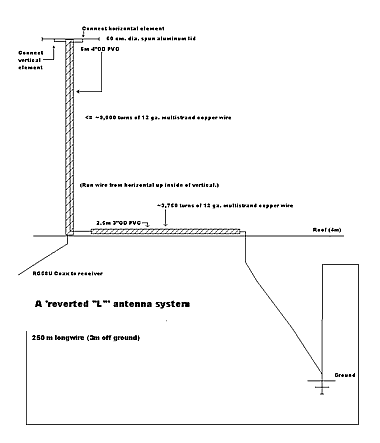Amazing
results with Broomstick
By Marty
Leipzig
Sr. Production Geologist, Qatar
October 1998
I am an American
expatriate on extended duty in the Middle East and have rekindled
my enjoyment of DX'ing.
My previous
overseas stints (Russia, Central Asia, Mongolia, Australia, Africa
and South America) enabled me only to take a small portable SW radio;
but being settled now has enabled me to indulge in some experimentation.
I currently
have a Radio Shack DX-390 (Drake R8B is currently on order) and
have used that here without any real noteworthy success.
I decided to try a long-wire antenna and see if that helped. 250
meters of 8 ga. speaker wire perched atop a 3 m tall wall helped
considerably.
Then I saw your website and the "broomstick" antenna intrigued
me.
So, I ginned up a 2.5 m long piece of 3" OD PVC pipe with over
2,000 turns of 12 ga. 8-strand wire.
I topped the thing with a 60 cm diameter spun aluminum "camel-pot"
lid, and connected one end of the aforementioned wire to the lid
and ran a ground down from the other side (we live in a very desert
country, so the ground under the air conditioning outlet was the
only ground less than bone-dry), and placed the whole gizmo up
on the roof (~5 m high).
I ran
my coax and plugged the contraption into the radio.
I was amazed at the improvement!
I can, on a fairly typical night, receive WWV out of Boulder,
CO, USA, on 10.0 MHz. That's approximately 15,000 Km from Qatar
(where I currently reside), so I'm quite pleased.
From receiving only local radio and some India transmissions,
my signal reception has increased easily by an order of magnitude
or more.
Thanks for the idea.
Now I wonder if a taller version of the contraption I have now
would increase my signal capture ratio any further; or is there,
as in most all things, a point of diminishing returns?
I also
ginned up a combination tuner/static discharge box by combining
two of the other articles found on your website. The tuner is
a real Rube Goldberg affair, made with a 30 cm hunk of left-over
3" OD PVC pipe and 60 turns of 12 ga. copper wire. That leads
into the two 12 pole rotary switches which are run through a capacitor/resistor/neon
bulb static trap.
With all that wire out there, that bulb really glows during one
of our less-than-infrequent sandstorms.

1.2 km wire
on a stick
gives amazing
results
By Marty
Leipzig
Sr. Production Geologist, Qatar
November 1998
Not content to leave well enough alone, I went and added
on a bit to the previous design (see below).
The previous "broomstick" was 2.5 m of 3" OD PVC. The new and
improved model is 6 m of 4" OD PVC.
The smaller, earlier version comprised some 3750 turns of 12 ga.
8-strand copper wire; the taller, later version carries some 9000
turns of the same (over 1.2 km of wire by my account (8x that
if you take into account the multistrand wire used).

Click
here for large image.
I mounted the 6 m portion vertically, and the 2.5 m section
horizontally (a "reverted "L"" system). I added in my 250 m random
long wire (it was there, so why not use it?), grounded the thing
and in great anticipation, plugged it into the radio.
The results were more than amazing.
Being in the Middle East, my benchmark was to hear WWV in Colorado.
With the previous antenna, I could hear the station, but the words
were weak and there was much fading (some of this was helped by
the antenna tuner I made out of leftover 12 ga wire and a 30 cm
section of leftover PVC); but with the present system, WWV sounds
like it's around the block. Crisp, clear, and virtually no fading.
Even I was impressed. I'm going to try different physical configurations
to see if there is an optimal orientation for this antenna system.
Also, before this, I was quite unable to receive stations
from Central and South America. I can now, regularly, receive
Quito, Havana and one or another in Argentina somewhere (although
I do admit that's getting fringe, but I'm still hunting).
Thanks to you and your website for the suggestions and helping
me to remember what a great hobby DX'ing is (I am a lasped ham
with no intention of getting back to broadcasting, I'm more than
content to while away the hours just listening for a change).
The best part of the antenna system, aside from providing
a diversion in the hot and humid days of early winter (remember:
I live in the Middle East), is it's ease of construction and ridiculous
inexpensiveness.
The wire was the only real outlay (and even that was a bargain
in bulk), the PVC was scrap from one of the numerous building
projects around here and the rest was solder, tape and time.
I figure the whole shebang set me back about QR100 (about USD$25),
and that includes the 60 cm camel-pot lid radiator, ackerman bolts
and plywood base I used to secure it to the roof of our villa.
|



